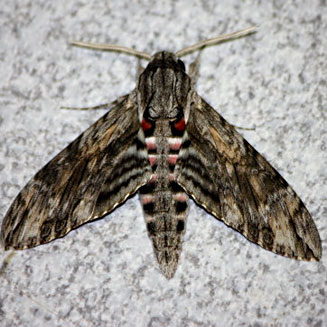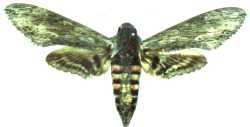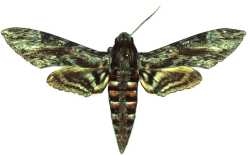|
Agrius convolvuli (Convolvulus hawkmoth, Sweet potato hornworm)
[= Herse convolvuli]
Life
> Eukaryotes >
Opisthokonta >
Metazoa (animals) > Bilateria > Ecdysozoa >
Panarthropoda > Tritocerebra > Phylum:
Arthopoda > Mandibulata >
Atelocerata > Panhexapoda >
Hexapoda
> Insecta (insects) > Dicondyla > Pterygota >
Metapterygota > Neoptera > Eumetabola > Holometabola > Panorpida >
Amphiesmenoptera > Lepidoptera (moths
and butterflies) > Glossata > Coelolepida > Myoglossata > Neolepidoptera >
Heteroneura > Ditrysia >
Apoditrysia > Obtectomera >
Macrolepidoptera >
Bombycoidea > Family: Sphingidae (hawkmoths) >
Subfamily: Sphinginae
 |
|
|
Agrius convolvuli (Convolvulus hawkmoth),
Brits, Northwest Province, South Africa, 9 October 2011. [photo Mike
Nyenes ©] |
|
|

|

|
|
Agrius convolvuli female (wingspan
94 mm), Krugersdorp, South Africa [photo J. Joannou ©] |
Agrius convolvuli male (wingspan =
116 mm), Krugersdorp, South Africa [photo J. Joannou ©] |
Distribution and habitat
A migratory species [from where to where?; distance?
purpose?] occurring widely in Africa, most neighbouring islands, Europe, and
Asia through to Australia (Pinhey 1975 pp. 135-136).
Life cycle
Ecological interactions
Larval host plants in southern Africa
Information from Kroon [1999] unless otherwise indicated
Pollination of flowers occurring in southern Africa
Adult moths feed from a wide variety of long-tubed flowers
including:
-
Amaryllidaceae
-
Caricaceae
-
Carica papaya (Papaya, Papaw, Pawpaw). A cultivated species,
pollinated by hawkmoths, including Agrius convolvuli. Martins &
Johnson (2009) in a study conducted in rural Kenya, found that natural
habitats were important in sustaining hawkmoth populations because they
contained the larval hostplants needed in completing the life cycle. Hence,
papaya plants grown near natural habitats were more likely to be pollinated
than those isolated from natural habitats.
-
Cucurbitaceae
-
Lagenaria siceraria (Bottle gourd, Calabash) - Morimoto et al.
(2004), in a study conducted in Kenya, considered hawkmoths, including
Agrius convolvuli, as the main pollinators of Lagenaria siceraria.
-
Iridaceae
-
Gladiolus longicollis.
At a site near Pietermaritzburg in
KwaZulu-Natal, South Africa, Alexandersson & Johnson (2002) found that this
species is pollinated mainly by Agrius convolvuli. Flowers are white
to cream and open in the evening, producing a strong, sweet scent that is
attractive to hawkmoths. A few other hawkmoths were found to have visited
this flower but their probosces were too short to reach the nectar at the
base of the tube. The probobscis of Agrius convolvuli is
exceptionally long, ranging from 85 - 135 mm long in its extended state. The
tube of Gladiolus longicollis ranges widely from 35 - 130 mm in
length. They found that flowers with longer tubes were more likely to
produce fruit than flowers with shorter tubes. If the tube is longer than
the moth's proboscis, then the moth has to press its head into the flower to
get to the nectar and in so doing presses it against the anthers and the
stigma where pollen transfer then takes place. If the tube is shorter than
the proboscis then the moth can reach the nectar without having to press its
head into the flower and hence does not pick up pollen.
-
Onagraceae
-
Orchidaceae
-
Aerangis. Most, if not all, of the species in this genus are
probably pollinated by long-tongued hawkmoths and Agrius convolvuli
in particular (see Martins & Johnson 2007). Confirmed records of pollination
by Agrius convolvuli for species occurring in southern Africa
include:
-
Disa cooperi. Johnson (1992) recorded
Agrius convolvuli feeding
from this flower but its proboscis is too long so the head of the moth is not
inserted far enough into the orchid to pick up the pollen. Another shorter
tongued hawkmoth was the main pollinator of this species.
-
Rangaeris amaniensis. Agrius convolvuli, Coelonia fulvinotata and
Xanthopan morganii recorded as pollinators by Martins & Johnson (2007)
in Kenya.
-
Verbenaceae
Links
Publications (by date)
-
Pinhey, E.C.G. 1975. Moths of Southern
Africa. Tafelberg, Cape Town.
-
Johnson SD. 1995. Observations of hawkmoth pollination in
the South African orchid Disa cooperi. - Nordic Journal of Botany 15:
121–125.
http://dx.doi.org/10.1111/j.1756-1051.1995.tb00128.x
-
Kroon, D.M. 1999. Lepidoptera of Southern
Africa - Host-plants and other Associations. A Catalogue. Published by
the author and Lepidopterists' Society of Africa, P.O. Box 477, Jukskei Park
2153, South Africa.
-
Alexandersson R, Johnson SD. 2002. Pollinator-mediated
selection on flower-tube length in a hawkmoth-pollinated Gladiolus
(Iridaceae). Proceedings of the Royal Society London B 269: 631–636.
http://dx.doi.org/10.1098/rspb.2001.1928
-
Morimoto Y, Gikungu M, Maundu P. 2004. Pollinators of
the bottle gourd (Lagenaria siceraria) observed in Kenya.
International Journal of Tropical Insect Science 24: 79-86.
http://dx.doi.org/10.1079/IJT20046
-
Kawaano S, Odaki M, Yamaoka R, Odatanabe M, Takeuchi M,
Kawano N. 2005. Pollination biology of Oenothera (Onagraceae).
The interplay between floral UV-absorbancy patterns and floral volatiles as
signals to nocturnal insects. Plant Species Biology 10(1): 31-38.
http://dx.doi.org/10.1111/j.1442-1984.1995.tb00118.x
-
Martins DJ, Johnson SD. 2007. Hawkmoth pollination of
aerangoid orchids in Kenya, with special reference to nectar sugar
concentration gradients in the floral spurs. American Journal of Botany
94(4): 650-659.
http://dx.doi.org/10.3732/ajb.94.4.650
-
Martins DJ, Johnson SD. 2009. Distance and quality of
natural habitat influence hawkmoth pollination of cultivated papaya.
International Journal of Tropical Insect Science 29: 114-123.
http://dx.doi.org/10.1017/S1742758409990208
|
